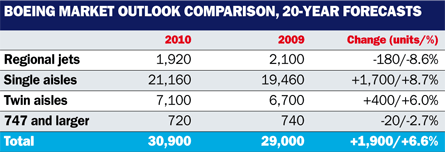Boeing has increased its forecast for commercial aircraft on the back of anticipated rising demand for single-aisle aircraft over the next 20 years, a market the airframer believes it will share with Airbus and at least one successful new market entrant.
The US airframer forecasts demand between 2010 and 2029 for 30,900 new aircraft worth $3.6 trillion, up from 29,000 in the previous year’s forecast. Since 2006 the airframer’s 20-year market for commercial aircraft has risen $1 trillion in value, from $2.6 to $3.6 trillion.
“We are expecting one or more of the new entrants to be successful and sell airplanes,” says Boeing vice president of marketing Randy Tinseth.
The increase is driven by anticipated robust demand in the single-aisle market, which has risen by almost 9% from 19,460 to 21,160 aircraft.
 |
|---|
© Spirit AerosystemsBoeing 737 production line |
“As I look out into the market I see the MS-21, the C919. I look at what the Koreans may be able to do, the Japanese might be able to do, Embraer might be able to do, what Bombardier will be able to do, I guess all I would say is when we look near term you have to look at CSeries and what Embraer may be doing and when you look long term you have to add one or two of those new guys into the mix,” says Tinseth.
The company’s long-term plans are matched by its near-term production rates, as the forecast over the next two decades comes just weeks after Boeing announced increases in 737 production planned for early 2012.
Yet, while the company raises output in the near term, Tinseth says the second decade of Boeing’s 20-year forecast weighs new market entrants more significantly.
The airframer estimates that 17,410 or 56% of the 30,900 aircraft will be for market growth, versus 13,490 aircraft that will replace aircraft in operation today. The balance, 5,400 aircraft, is expected to be retained by the world’s fleet, making up a total global fleet of 36,300: a 92% increase over today’s fleet of 18,890.
Boeing also anticipates increased twin-aisle demand in its 777 and 787 segments, rising to 7,100 aircraft from 6,700 in 2009.
It sees the market consolidating around aircraft in the 100- to 400-seat range. Both the large and regional aircraft segments were adjusted downward for the third year straight to 720 and 1,920 units, down from 740 and 2,100, respectively.
 |
|---|
Source: FlightGlobal.com























